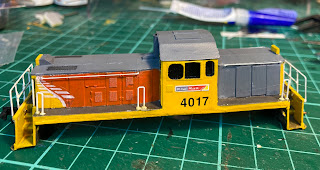DB recalls somewhat verbosely:
A long time ago, in a galaxy far, far away, I purchased four well-travelled CE tops from Shapeways - in 2013.
They were unpacked recently and I thought they might make for yet another quick project that will keep me away from finishing that last leg and thus progressing Studholme.
Some hopper history. On the Midland Line coal trains, the aluminium CB wagons started to replace four wheeled highsiders in 1989. CBs were a derivation of the North Island CA class but with longitudinal doors underneath as it was feared the wet west coast coal would get stuck in the little transverse doors.
Extra CBs were converted from CF fertiliser wagons as coal tonnages picked up, and hungry boards were added to the tops of all of them to further increase capacity.
The stainless steel CC class arrived on the scene in the mid 1990s, a taller and longer wagon intended to be loaded with considerably more coal as soon as the Midland Line's track and bridges were upgraded to take higher axle loads. That never happened, so the one-bay-shorter CEs came about, and CCs still run around with plywood formers inside the ends to prevent them from being overloaded.
As the CEs were entering service, some second hand bauxite tubs from Western Australia were purchased, and these became the CW class with their distinctive lower sides. They initially ran as a set, but then they were split up so for a period it was not uncommon to have real mixtures of wagons in the west coast coal trains, with a block of modern CE/CC wagons at the east end, a block of CBs in the middle and some CWs at the west end (from memory to do with braking when loaded, although I do have pictures with some CWs at the east end of trains).
The bigger CE/CE wagons are labeled for unidirectional unloading, and now there is no balloon loop at Lyttelton, I guess they shuffle out and back to Ngakawau, Reefton, Ikamatua (Pike River) and (rarely) to Rapahoe with little bother. They'd have to be careful at Stillwater to leave from the same leg of the triangle they came in on to avoid reversing the rake.
The Genesis CET wagons used to bring coal to the Waikato from the Bay of Plenty ports are basically CEs with roof hatches, and the YJ ballast wagons were derived from the CE design.
Anyway, back to the models.
As mentioned in that post from 11 years ago, the shells from Mr Lister are fairly strata free except on the sloped ends. I attacked that with a triangular file to take some of the edge off, I'll give myself a C- grade on that effort. The sides were sanded with some fine sandpaper, but now that I have applied some paint they seem as gritty looking as ever.
Now that I have foolishly painted the shells, in a bass-ackwards way I figured I should detail them. D'oh.
So after trawling through the stash for CE pictures, it seems:
- One end platform of the wagon, the Lyttelton-facing end, is basically empty save for a set of four wooden wheel chocks.
- The other, west coast-facing end, has a long air tank (there seem to be different lengths or positions of these), some braking bits and bobs, and a handwheel.
- There are two air pipes of different sizes running along one side, these end up going down into the end platforms via metal gymnastics. I'll probably just do one pipe unless I suffer from a burst of enthusiasm.
- There are handrails on one corner of each end.
- There are trippers for the doors on both sides, these always seem to face to the left when viewed from the sides. I assumed they would face one coast or the other.
- There are some prominent jacking pads on the bodysides.
- The model shell has a little flap at the top on one end. I have prototype pics of flap with a ladder attached to it, ladder with no flap, flap without ladder, and no flap or ladder. The flap was probably intended to protect the air tank and brake valves, so I'm thinking they started with a flap for protection, then decided they really needed ladders, then later on, decided to dispense with the flap. The wagons mainly seem to be in 'no flap with ladders' configuration these days. Perhaps someone in the know can share some actual facts.
Drilling holes in the end platforms for brass ladders (below) to minimise the chances of them being knocked off - I decided to keep the flaps on two wagons and cut them off the other two for some variety. A brass airpipe has been painfully bent and secured in place along the correct side.
Ladders in place and handbrake wheels too (below). The handbrake supports were over engineered with an angled piece of plastic rod with a thin square attached on top, all drilled out for an N scale handwheel donated by some unloved American wagons. The angled support was shaped at the bottom to plug into a hole drilled in the end platform. This looks almost perfect on the wagon below. On the other three the angle was too great (I forgot that the platform top also slopes down at the sides) so those ones lean a bit more than they should.
And finally with some paint on these new details (below).




















